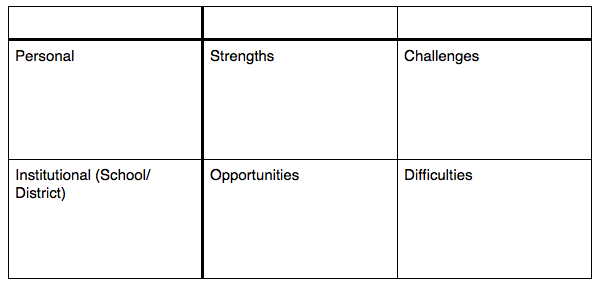Today we talked about the issue of blind-spots, blindsight and implicit association bias. It’s a difficult topic, how can we compensate for beliefs and attitudes we hold, but aren’t aware of?
I was thinking about it in the context of my project. Primary teachers attending a workshop about technology integration will have a variety of perceptions about technology. At the end of last week I wondered about how to get teachers on board in my post. I think part of the solution is making visible the invisible. We need to talk about those implicit beliefs and make them explicit. If we are aware of our own biases, we can try to adjust for them, but if we never talk about our own struggles and stumbling blocks how can we get over them? I started working on my workshop plan, and I added a section for teachers to talk about their SCOD: strengths, challenges, opportunities, and difficulties (thanks, Jenny for the definition). I created a chart for them to fill out and reflect on:
 I was going to put “positives” and “negatives” at the top of the columns, but I’m considering the linguistic cognitive domain and don’t want to call challenges and difficulties “negative”. I’ll try to come up with a better word. I think by talking about the things teachers struggle with and acknowledging them as something to have to consider, teachers will be more open to the suggestions I am offering in the workshop. By knowing the limitations specific to their situation I will also be better able to help them in their planning.
I was going to put “positives” and “negatives” at the top of the columns, but I’m considering the linguistic cognitive domain and don’t want to call challenges and difficulties “negative”. I’ll try to come up with a better word. I think by talking about the things teachers struggle with and acknowledging them as something to have to consider, teachers will be more open to the suggestions I am offering in the workshop. By knowing the limitations specific to their situation I will also be better able to help them in their planning.
I have been thinking about self-efficacy too, and how to keep my momentum after this course. Following technology and and book review blogs on RSS this spring has kept these at the top of my mind, and I feel connected to what other educators are talking about. I think the next step for me is sharing what I know. I am starting to realize that I have ideas worth sharing, and that I need to find a platform for them. Twitter is kind of like listening to multiple conversations happening at a cocktail party, you can hear what everyone is saying, and jump in when you have a relevant comment. Although the ideas discussed can be deep, I feel the interactions are superficial, I struggle with the 140 character limit.
I’ve been thinking about what Jenny said about teachers having a voice and a vision for the future of education, and also to enable the public to see more about our job than just the negative headlines about bargaining. My classroom blog is a window into my classroom, a platform for me to show parents what we are doing, and share resources that can help their child’s learning. I don’t think it is the place to share my struggles and triumphs within the education system , or my vision for the future. I’m thinking I should start another blog, one where I could show the public what a complex profession teaching really is. I would have to consider privacy, because if I am talking about events with real students, I would not want parents to be upset reading it. But I’m not sure how I would talk about my experiences without talking about my students, since they make up such an integral part of my job. And I can’t talk about vision without talking about specific experiences, because those shape a vision. I don’t quite know how to tackle that, but I’m going to ponder it.
One reply on “Almost done, but really just beginning”
I couldn’t agree more, that we need to make the invisible visible. When we can talk about the seen and unseen forces that influence our perceptions and practice, we can make informed decisions about how we want to proceed rather than being buffeted by circumstances that appear to be beyond our control. I like SCOD, although it was a quick response as an alternative to SWOT analysis, which I think is wholly inappropriate for educational settings. With regards to blogging about professional development, there is a place to write about experiences in classrooms while preserving the anonymity of the students. This is how educational research gets written up. If we couldn’t refer to real life events, we wouldn’t be able to discuss extant situations or what we might be able to do about them.